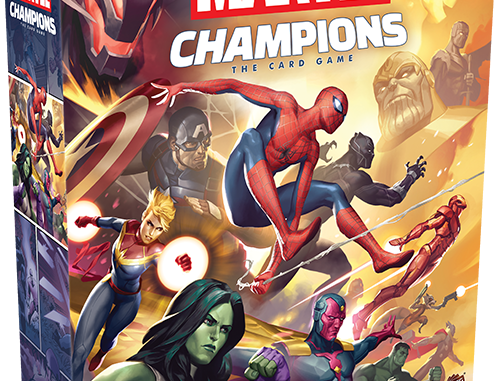
I first played this game after a friend brought it over. We played through the first scenario and it was fun. Enjoyable enough to add it to my birthday list, but not one I felt to strongly about. My wife ended up getting it for me. My son and I have since gone off the deep end with it. There’s your quick and dirty summary of the game.
Gameplay- A

The goal of the game is for a group of 1-4 heroes to defeat the schemes of an evil super-villain. You play one of a variety of Marvel’s superheroes and work together to defeat the villain. In short, it’s a cooperative card game.
To defeat the villain, you must reduce their hit points to zero. You need to do this before they finish their Scheme or defeat each of the heroes. Each villain has a main Scheme and several side schemes that can get played from their deck. They also have minions and events that will do many nasty things to the heroes. The heroes will have to work together and balance out Thwarting the Scheme, doing damage to the villain or minions and gearing up for future turns.
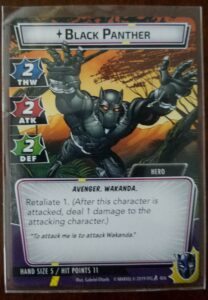
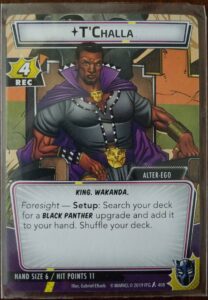 Each hero consists of a two sided card; Alter-Ego and Hero. The Alter-Ego side can’t be attacked and has the ability to heal yourself (Recover). The Hero side has three stats; Thwart, Attack, Defense. The Thwart value is used to remove counters from the villain’s Schemes to keep them from completing (or to remove side schemes from play). Attack is straightforward doing damage to a target, usually the villain but also minions. Defense is used to reduce damage when you are attacked. To use any of these abilities, you need to exhaust your hero. That means if you defend against an attack, you won’t be attacking or thwarting on your turn.
Each hero consists of a two sided card; Alter-Ego and Hero. The Alter-Ego side can’t be attacked and has the ability to heal yourself (Recover). The Hero side has three stats; Thwart, Attack, Defense. The Thwart value is used to remove counters from the villain’s Schemes to keep them from completing (or to remove side schemes from play). Attack is straightforward doing damage to a target, usually the villain but also minions. Defense is used to reduce damage when you are attacked. To use any of these abilities, you need to exhaust your hero. That means if you defend against an attack, you won’t be attacking or thwarting on your turn.
In addition to those basic abilities, each side usually also has a special ability that can only be done when on that side. Often these abilities do not require your character to exhaust so you can do them on top of the basic abilities. There are also cards that can only be used when your character is flipped to a certain side. Once per turn, you are allowed to flip from one to the other so deciding when to be which side is an important aspect of your strategy.
Each side of a character has a different hand limit, the Hero side usually being lower, which only applies when you draw cards at the end of each Hero Phase. Cards are used for two purposes. First, each card can be played for their effect. There are four main types of cards; Events, Support, Ally, Upgrade. You pay for a card using resources generated by spending other cards. So to play a two cost card, you’ll need to discard two other cards to generate the resources. There are some cards that generate more than one resource but they usually don’t have any other effect.
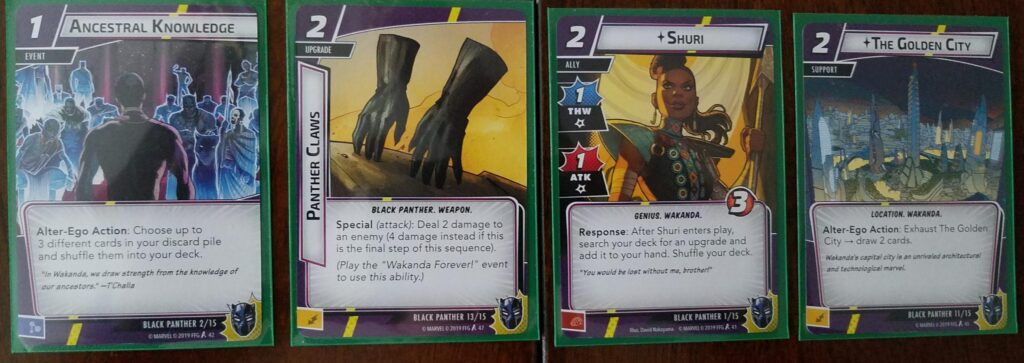
Event cards are one time use, play them and do a thing. These all have a timing trigger on them as to when they can be played. Response keyword means they have an effect that triggers after something else happens, which can include on the villains turn. Action cards are done during your turn.
Support cards are ones that stay in play and can be used multiple times for an effect. Some of them have counters that you remove which limit the overall number of times they can be used. Others just get exhausted when used so will remain in play for use each round.
Allies are characters that help your team. Most heroes have at least one Ally in their character deck that is a fundamental sidekick for that hero. Ironman has Warmachine, Black Panther has Shuri for example. Allies have Thwart, Attack and Health values and sometimes an ability. For most Allies, to use their Thwart or Attack they also take a consequential damage. If they have three health, that means you can only use them three times before they are discarded. They can be healed, which is one strategy for keeping those really expensive and valuable Allies out there longer. It is not always a bad thing either for them to be discarded. Many Allies have abilities that only trigger when they are played, so discarding them means they can be played again later. They can also defend, which is the main use for their final hit point. If a villain is attacking any hero, any Ally can defend against and take all the damage. This is exceedingly valuable for staying alive.
Upgrade cards are similar to support cards in that they stay in play and provide some benefit. Unlike support, upgrades typically enhance something about your hero. Increasing your Thwart, Attack or Defense, for example. Some upgrades are iconic items, like Mjolnir or Cap’s shield. Some characters revolve around getting out lots of upgrades, like Ironman or Black Panther and their suits of armor.
The game is a resource and action management game at its core. You need to balance your precious resources in order to get the most useful cards into play. You also need to balance your actions. Do you Thwart and keep the scheme from growing and losing you the game? Do you attack and try to win? Do you defend against an attack to save some hit points but not be able to do either on your turn?
Production- B+
Beyond gameplay, the core appeal of the game, as something worth spending money on, comes from the fact it is a Living Card Game (LCG) rather than a Trading Card Game (TCG). Previously, my only experience with LCG’s was FFG’s old Star Wars: The Card Game. It was okay, but I didn’t like the limited deck building options so never felt the desire to invest beyond the starter box. I had played Magic back in middle school, got kind of into the TCG they tacked onto Star Wars Galaxies toward the end of its run, and was really invested in Star Wars Destiny for a short time. I liked customizing decks.
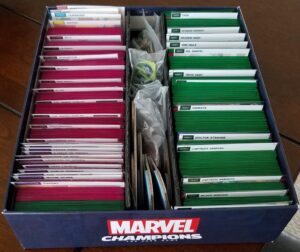 However, I absolutely HATE the business model of TCGs. Spending a bunch of money and NOT finding the card you want irks me. It’s exploitative and manipulative. It’s gambling. So the idea of LCG’s has always appealed to me. The core box has everything you need to play several characters and several bad guys. There’s not a lot of deck variations you can do but there are some. If nothing else, switching aspects between heroes is something different every time.
However, I absolutely HATE the business model of TCGs. Spending a bunch of money and NOT finding the card you want irks me. It’s exploitative and manipulative. It’s gambling. So the idea of LCG’s has always appealed to me. The core box has everything you need to play several characters and several bad guys. There’s not a lot of deck variations you can do but there are some. If nothing else, switching aspects between heroes is something different every time.
The only real complaint about the production of the core box is the storage. The tray comes with groves, presumably for dividers, but there’s nothing included that fit in there. Most dividers for card storage don’t fit in that space either. We ended up tossing the divider and using some cardstock for dividers and building a tray in the middle out of foamcore.
Theme- A
You’re playing superheroes. Bigger than life abilities. Bigger than life bad guys. But what really captures the theme well is the cooperative nature of the game. You are heroes working together to defeat the bad guy.
I’m not a huge comic book nerd. My fandom is mostly tied to the MCU. I’ve read a handful of comics but mostly to get a back story or see where the inspiration for a movie came from. That said, I can see the personality of the superheroes in their decks. Each feels unique and different from each other and true to the character. It’s not bland repeats with different artwork.
Expansions- A
There are many. I’ll probably start reviewing different characters and some build combos for them in the future. But each one comes with a full playable deck plus a set of cards from the other aspects that work well with that new hero. There are also villain packs and the first big box combo adding both heroes and villains.
Conclusion- A
This game managed to hit all the buttons for me. LCG, familiar world, cooperative and deck building. It manages to overcome some of the flaws of a lot of similar games. For example, Sentinels of the Multiverse is very similar in that you’re playing a card game of superheroes in a cooperative fight against a super villain. Aside from the deck building aspect that Sentinels lacks, Champions manages to avoid feeling quite as frustrating. Some of that may be to the relative newness. As more and more characters and villains come out we may run into some mechanics that prove more annoying than fun. But Sentinels had a lot of that built in. Specifically, how many villains could wipe out every card your heroes had played up until that point, which with some heroes completely neutered them. So far, there is no similar mechanic for Champions. You can lose items but it’s one and few and far between.
The Alter-Ego mechanic also overcomes another problem in that you can flip to that side to avoid damage and gain a round to rest and recover. Deciding when and how often to flip is a core mechanic. In games like Sentinels you could see your death coming and there will be nothing you can do about it. That’s still possible but so far, you usually have some choice to make. Likewise, the last round sometimes feels inevitable but only barely. So far, unlike some cooperative games, the end result hasn’t felt predetermined multiple rounds in advance.
Additionally, there’s also tons of re-playability with different deck builds, hero combos and villain deck combos. And even more coming out each month.
